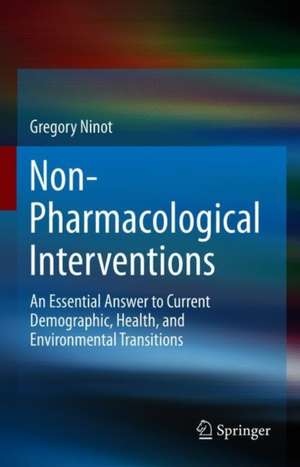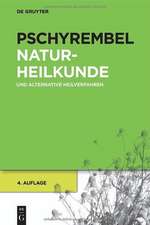Non-Pharmacological Interventions: An Essential Answer to Current Demographic, Health, and Environmental Transitions
Autor Gregory Ninoten Limba Engleză Hardback – 28 noi 2020
· Defining Non-Pharmacological Interventions
· The Benefits and Dangers of Non-Pharmacological Interventions
· Motives and Facilitators of Non-Pharmacological Intervention Use
· The Market for Non-Pharmacological Interventions
· Evaluation of Non-Pharmacological Interventions · The Future of Non-Pharmacological Interventions
Non-Pharmacological Interventions: An Essential Answer to Current Demographic, Health, and Environmental Transitions is a must-have resource for clinicians and other health professionals, researchers, students, health insurers,policy-makers, caregivers, and entrepreneurs in the health and wellness space, as well as any users who wish to inform themselves about NPIs.
| Toate formatele și edițiile | Preț | Express |
|---|---|---|
| Paperback (1) | 344.83 lei 38-44 zile | |
| Springer International Publishing – 28 noi 2021 | 344.83 lei 38-44 zile | |
| Hardback (1) | 377.16 lei 43-57 zile | |
| Springer International Publishing – 28 noi 2020 | 377.16 lei 43-57 zile |
Preț: 377.16 lei
Preț vechi: 397.01 lei
-5% Nou
Puncte Express: 566
Preț estimativ în valută:
72.19€ • 78.44$ • 60.68£
72.19€ • 78.44$ • 60.68£
Carte tipărită la comandă
Livrare economică 21 aprilie-05 mai
Preluare comenzi: 021 569.72.76
Specificații
ISBN-13: 9783030609702
ISBN-10: 3030609707
Pagini: 294
Ilustrații: XXIII, 294 p. 29 illus., 24 illus. in color.
Dimensiuni: 155 x 235 x 19 mm
Greutate: 0.63 kg
Ediția:1st ed. 2021
Editura: Springer International Publishing
Colecția Springer
Locul publicării:Cham, Switzerland
ISBN-10: 3030609707
Pagini: 294
Ilustrații: XXIII, 294 p. 29 illus., 24 illus. in color.
Dimensiuni: 155 x 235 x 19 mm
Greutate: 0.63 kg
Ediția:1st ed. 2021
Editura: Springer International Publishing
Colecția Springer
Locul publicării:Cham, Switzerland
Cuprins
Preface.- Chapter 1 - Definition of Non-Pharmacological Interventions (NPIs).- Chapter 2 - The Reasons for the Success of Non-Pharmacological Interventions.- Chapter 3 – Mechanisms Involved in Non-Pharmacological Interventions.- Chapter 4 – The Benefits of Non-Pharmacological Interventions.- Chapter 5 – The Dangers of Non-Pharmacological Interventions.- Chapter 6 – Motives and Facilitators of Non-Pharmacological Intervention Use.- Chapter 7 – The Market for Non-Pharmacological Interventions.- Chapter 8 – Evaluation of Non-Pharmacological Interventions.- Chapter 9 – The Future of Non-Pharmacological Interventions.- Chapter 10 – Conclusion.- Appendix: Useful Websites.
Notă biografică
Gregory Ninot, PhD, is full professor at the University of Montpellier and at the Montpellier Cancer Institute in France. He has followed a dual curriculum in sports sciences (Master’s, PhD) and psychology (Master’s, PhD) applied to health. Since 1999, his basic research has focused on integrated models explaining psychological and behavioral adjustment to chronic disease and healthy aging. His applied research focuses on assessing the benefits, risks, and cost-effectiveness of non-pharmacological interventions (NPIs). He is the author of more than 150 articles in international scientific and medical journals and 11 books. He has led several multidisciplinary academic research units interested in health issues. He founded and currently manages a University collaborative platform, the Plateforme CEPS; organizes an annual international conference (iCEPS Conference, www.icepsconference.fr); and develops digital tools (e.g., www.motrial.fr, www.nishare.fr, www.niri.fr) to improve NPI assessment and evidence-based practices. Since 2014, he has run a blog on NPIs (www.blogensante.fr/en/).
Textul de pe ultima copertă
Non-pharmacological interventions (NPIs) have become essential solutions for better living, preventing disease, and self-care, in addition to biomedical treatments, and for increasing longevity without loss of quality of life. Over the past 20 years, these practices have gone from general diet and hygiene advice to targeted and personalized solutions for prevention, care optimization, and curative treatments. Selected empirically for centuries or recently with the help of technological innovations and epigenetic, interventional, and medico-economic studies, their development is growing and diversifying around the world. Today an NPI ecosystem is made up of a myriad of public and private actors. As interest in NPIs grows, so do questions about safety, effectiveness, standardization, ethical practice, and surveillance. In this book, the author answers these questions with a scientific approach, because evidence-based science, evidence-based practice, clinical research, and data monitoring have revolutionized this field.
Topics explored among the chapters include:
· Defining Non-Pharmacological Interventions
· The Benefits and Dangers of Non-Pharmacological Interventions
· Motives and Facilitators of Non-Pharmacological Intervention Use
· The Market for Non-Pharmacological Interventions
· Evaluation of Non-Pharmacological Interventions
· The Future of Non-Pharmacological Interventions
Non-Pharmacological Interventions: An Essential Answer to Current Demographic, Health, and Environmental Transitions is a must-have resource for clinicians and other health professionals, researchers, students, health insurers, policy-makers, caregivers, and entrepreneurs in the health and wellness space, as well as any users who wish to inform themselves about NPIs.
· Defining Non-Pharmacological Interventions
· The Benefits and Dangers of Non-Pharmacological Interventions
· Motives and Facilitators of Non-Pharmacological Intervention Use
· The Market for Non-Pharmacological Interventions
· Evaluation of Non-Pharmacological Interventions
· The Future of Non-Pharmacological Interventions
Non-Pharmacological Interventions: An Essential Answer to Current Demographic, Health, and Environmental Transitions is a must-have resource for clinicians and other health professionals, researchers, students, health insurers, policy-makers, caregivers, and entrepreneurs in the health and wellness space, as well as any users who wish to inform themselves about NPIs.
Caracteristici
Clears the confusion between non-pharmacological interventions (NPIs) and alternative medicines Is based on science vs. anecdotal evidence/personal experiences or biases due to conflict of interest Offers an understanding of NPIs in the context of a global viewpoint Sorts through the ambiguities of NPIs by focusing on using the same language for NPIs Chooses the best combination of NPIs following specific key elements and guidance Details opportunities for practice, research, and business of this new ecosystem















